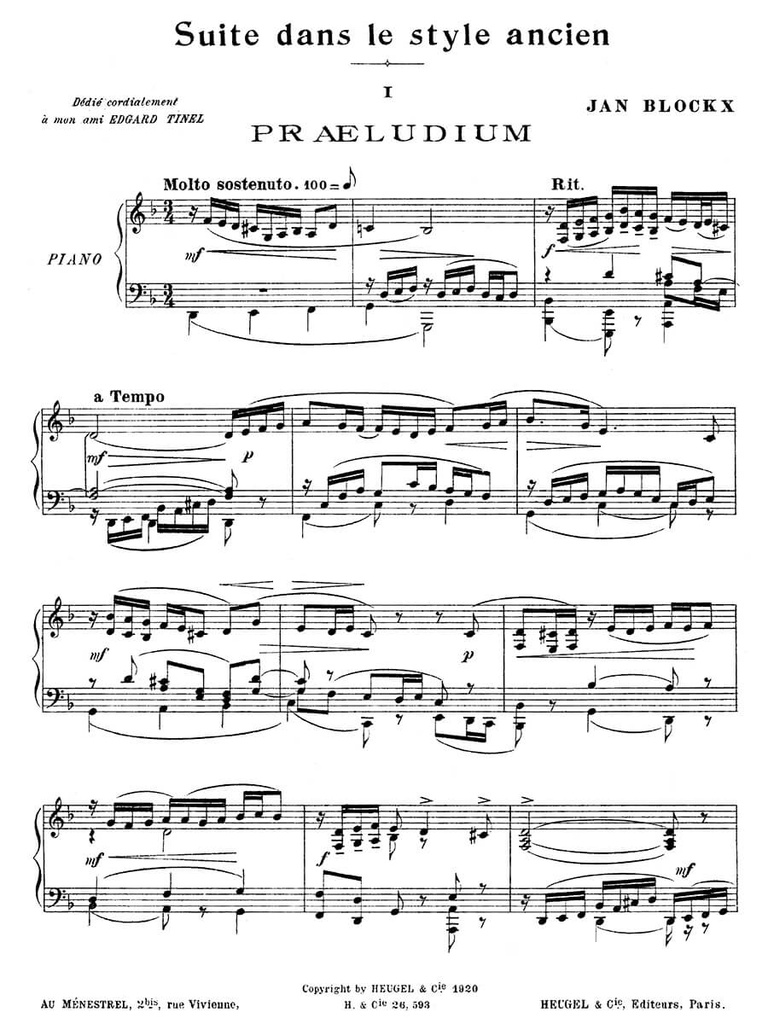Suite dans le Style Ancien
Description
Jan Blockx - Suite in Ancient Form
(1906-1907)
(Antwerp, 25 January 1851 – Antwerp, 26 May 1912)
Jan Blockx started studying music at the Ecole de Musique de la ville d’Anvers (Music school of the city of Antwerp). His teacher was Frans Aerts, who concurrently served as choir master of St Paul’s in Antwerp. Subsequently he pursued further studies at the new Vlaamsche Muziekschool van Antwerpen (Flemish Music School of Antwerp) where he took classes with Joseph Callaerts (organ) and Peter Benoit (harmony, counterpoint and fugue, composition). In the years 1879-1880 he made a study tour through Germany. Together with the Belgian-American composer Frank Van der Stucken he spent some time in Leipzig, where he was tutored by Carl Reinecke and was in touch with Edvard Grieg as well. In Leipzig Blockx composed several songs, piano music and the orchestral work Symfonische taferelen (Symphonic Tableaux). In the company of Van der Stucken he also travelled to Italy. In 1885 Blockx became teacher of harmony at the Flemish Music School which was to be upgraded to Koninklijk Vlaams Conservatorium (Royal Flemish Conservatory) in 1897, due to the efforts of Peter Benoit. After Benoit’s death Blockx became its second director.
Blockx was the most successful Belgian opera composer of his generation: the opera houses of Antwerp and Brussels competed to premiere his operas, and thanks to the support of the Paris publisher Henri Heugel his work was distributed and performed internationally. His most popular opera Herbergprinses (Princess of the Inn, 1896) was staged even in South Africa and the United States (in the French version Princesse d’Auberge). The success of his operas was due to the felicitous combination of romantic-realistic librettos, melodious, generously orchestrated music, and the admixture of a Flemish ‘local colour’ that permeated the story, the staging and the score.
Blockx most enthusiastically wrote plenty of vocal music (besides operas also cantatas, choral works and songs), but he also authored piano and chamber music as well as symphonic music. His best-known orchestral work remains Vlaamse dansen (Flemish Dances, 1884), still overshadowing later works such as his Symfonie in D (1885) and Suite in de oude vorm (Suite in Ancient Form, 1906-1907).
Blockx composed his neobaroque pastiche Suite in Ancient Form in four movements as a homage to the suites of Johann Sebastian Bach. The Prelude opens with a motoric theme introduced by the strings and developed into a crescendo, the wind instruments together with the harp then superposing a choral-like theme. Both motifs concurrently work towards a finale in triple forte. The following Aria starts with the violins and violas that evolve in unison (and as much as possible on the fourth string) above a running bass in the cellos and the double basses. Above this bass part that continuously runs on, the woodwinds bring a new theme, which is subsequently joined by the opening theme of the violins. The Sicilienne is in keeping with tradition pastorally coloured by the flutes, clarinets and bassoons; their solo parts are accompanied by pizzicati in the strings and by harp chords. The Gavotte is added lustre to by the trumpets and the timpani which join the orchestra for the first time. The contrasting Musette in the middle part is beautifully coloured by harmonies above which, again in a pastoral atmosphere, the woodwinds perform a solo. A return to the gavotte concludes this dancing part in a spectacular way. The coupling of gavotte and musette which often occurs in Baroque suites was picked up again in the 19th and 20th century by composers who wanted to evoke the Baroque style. Well-known examples are Joachim Raff’s Suite für das Pianoforte op. 200 (1875), Aus Holbergs Zeit (1897) by Edvard Grieg, Arnold Schönberg’s Gavotte und Musette (im alten Style) für Streichorchester (1897), the ballet Les ruses d’amour op. 61 (1898) by Alexander Glazunov or Gavotte et musette (1919) by Selim Palmgren.
Blockx’ neobaroque suite was premiered on 18 February 1907 in Antwerp by the orchestra of the Maatschappij der Nieuwe Concerten (Society of New Concerts), conducted by its chief conductor Lodewijk Mortelmans. During the same concert Fritz Kreisler played Felix Mendelssohn-Bartholdy’s violin concerto op. 64 and work by Tartini, Porpora, Couperin, and Paganini. Furthermore the programme featured the overture to Benvenuto Cellini by Hector Berlioz and the Symphony in F op. 9 by Hermann Goetz.
Blockx also arranged this suite (Repertoire Explorer 568) for piano, dedicating the Praeludium to his colleague Edgar Tinel, the then director of the Higher Institute for Church Music (aka the Lemmens Institute) in Mechelen. Both the orchestra and the piano version were published by the Parisian publishing house of Heugel which also published several operas by Blockx.
Jan Dewilde (translation: Joris Duytschaever)
Reprint of a copy from the library of the Royal Flemish Conservatoire of Antwerp. For the orchestral materials, please apply to the library of the Royal Flemish Conservatoire. This score has been published in collaboration with the Research Centre for Flemish Music (www.svm.be).
- Winkel Antwerpen : Disponible
